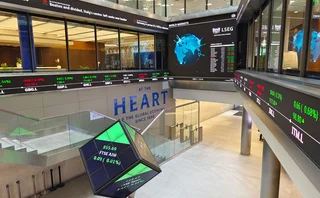
SSA deal of the year: Fannie Mae
Risk Awards 2017: Mortgage giant refines risk-sharing deals as political landscape shifts

Uncertainty over the future of Fannie Mae and Freddie Mac is best illustrated by a graph of their stock over the past two months.
After Steven Mnuchin, nominee for the post of US Treasury secretary, talked on November 30 about the need to quickly get the two giant mortgage intermediaries "out of government control", Fannie Mae shares leaped 46% in a day – investors presumably hoping for the firms to be recapitalised and released into the private sector.
The stock is now 16% below that peak. During Mnuchin's confirmation hearing on January 19, he clarified his earlier remarks: "My comments were never that there should be recap and release."
Whatever policy is ultimately adopted, the arrival of a new administration offers reform sooner rather than later – and the shape of that reform package has huge implications for financial system risk, and the functioning of the huge US mortgage market.
Both firms are trying to prepare for a new stage in their history by showing they can transfer credit risk to the private sector – radically expanding their traditional practices, in which interest rate and liquidity risk were managed via securitisation, while credit risk was retained and guaranteed, often through the use of insurance. Fannie Mae wins this year's award on the back of its cleverly evolving risk transfer Connecticut Avenue Securities (Cas) programme.
"I think Fannie Mae runs a great programme in terms of really helping redefine the US housing market post-financial crisis. I can't think of anything as transformational for the entire financial ecosystem as the Cas programme," says a securities trader at one US asset management firm.
If you want to know what the losses were on older vintage loans that had similar profiles to the latest Cas deal, you can easily view those losses with the tool
Financial adviser at a US bank
In outline, the Cas programme looks like any securitisation of credit risk. The first deals were done in 2013, and have continued at a steady pace since then, totalling more than $21.2 billion in issuance and transferring a slice of the risk on total unpaid principal of around $721 billion. The deals are tranched to appeal to different investor groups, offering more or less subordination and a range of coupons.
It is hard to say how Fannie Mae would have performed during the crisis if the programme had been in place at the time – the government sponsored enterprise's (GSE) loan portfolio has changed, and not all loans are eligible for inclusion in Cas – but the firm's analysis suggests the full extent of the losses would have been mopped up by investors, rather than the taxpayer. Lifetime losses on 2006-vintage loans with Cas-like attributes are just under 3%, for example, while last year's Cas-C01 deal covered losses up to 4%. Lifetime losses on other loans bought by Fannie Mae in the pre-crisis and crisis period are much higher.
Working on these foundations, Fannie Mae introduced some new features to the programme last year, with the aim of broadening the investor base, encouraging liquidity in the securities, and transferring more of the risk.
As one example, it has been trying to give investors more insight into the risk of the underlying mortgage pools, releasing a tool called Data Dynamics in 2016.
The service lets investors analyse historical loan performance data on more than 23 million loans dating back to 2000.
"It is a very user-friendly investor tool," says a financial adviser at one US bank. "If you want to know what the losses were on older vintage loans that had similar profiles to the latest Cas deal, you can easily view those losses with the tool. [It is much easier than] having to download data on millions of loans and do the comparison yourself."
Deal structures have also changed. For the first time, the junior mezzanine tranches in the new deals – known as 1M-2 and 2M-2 – have been publicly rated, a move that has been well received by investors.
Our goal for developing a credit risk transfer program was to help build a stronger and more resilient company
Laurel Davis, Fannie Mae
"We have long been advocating for ratings to second-loss bands for reasons of liquidity overall and broader sponsorship. Some money managers are limited in terms of buying non-rated assets," says a credit trader at a US asset management firm.
Ratings also make it easier for investors to repo the paper.
The reaction was so positive that Fannie Mae was urged to get past issuances rated as well, which they did in August. A financial adviser at a US bank says the spreads on those bonds subsequently tightened by 10–15 basis points.
"That is typically something issuers don't do, because why would you get a rating for something already out in the market? But we had enough feedback from investors and we worked with rating agencies and engaged them to specifically go back and look at these older transactions," says Laurel Davis, vice-president of credit risk transfer at Fannie Mae.
In addition, the M-2 class of debt in the new deals now has a feature allowing the bond to be split as the underlying pool pays off; ordinarily, as the risk falls, the bond would be upgraded, resulting in commensurately lower yields. Investors in CAS-CO1 will be able to split upgraded paper into an investment-grade and non-investment grade portion, potentially allowing them to sell off the higher-rated portion.
One criticism of the earlier deals was that hedge funds made up too big a slice of the investor base, potentially making it too sensitive to changes in price. Funds continue to be big investors in the recent deals, making up 48% of the investor base in the M-2 tranche, but Davis argues the investor group is diverse enough to ensure liquidity remains healthy under all conditions, and the participation of asset managers in the M-2 tranche has increased significantly.
"Our goal for developing a credit risk transfer program was to help build a stronger and more resilient company. We have achieved a lot of progress against this goal, but of course there is always more work to do," says Davis.
Only users who have a paid subscription or are part of a corporate subscription are able to print or copy content.
To access these options, along with all other subscription benefits, please contact info@risk.net or view our subscription options here: http://subscriptions.risk.net/subscribe
You are currently unable to print this content. Please contact info@risk.net to find out more.
You are currently unable to copy this content. Please contact info@risk.net to find out more.
Copyright Infopro Digital Limited. All rights reserved.
As outlined in our terms and conditions, https://www.infopro-digital.com/terms-and-conditions/subscriptions/ (point 2.4), printing is limited to a single copy.
If you would like to purchase additional rights please email info@risk.net
Copyright Infopro Digital Limited. All rights reserved.
You may share this content using our article tools. As outlined in our terms and conditions, https://www.infopro-digital.com/terms-and-conditions/subscriptions/ (clause 2.4), an Authorised User may only make one copy of the materials for their own personal use. You must also comply with the restrictions in clause 2.5.
If you would like to purchase additional rights please email info@risk.net
More on Awards
Clearing house of the year: LCH
Risk Awards 2025: LCH outshines rivals in its commitment to innovation and co-operation with clearing members
Best use of machine learning/AI: CompatibL
CompatibL’s groundbreaking use of LLMs for automated trade entry earned the Best use of machine learning/AI award at the 2025 Risk Markets Technology Awards, redefining speed and reliability in what-if analytics
Markets Technology Awards 2025 winners’ review
Vendors jockeying for position in this year’s MTAs, as banks and regulators take aim at counterparty blind spots
Equity derivatives house of the year: Bank of America
Risk Awards 2025: Bank gains plaudits – and profits – with enhanced product range, including new variants of short-vol structures and equity dispersion
Law firm of the year: Linklaters
Risk Awards 2025: Law firm’s work helped buttress markets for credit derivatives, clearing and digital assets
Derivatives house of the year: UBS
Risk Awards 2025: Mega-merger expected to add $1 billion to markets revenues, via 30 integration projects
Interest rate derivatives house of the year: JP Morgan
Risk Awards 2025: Steepener hedges and Spire novations helped clients navigate shifting rates regime
Currency derivatives house of the year: UBS
Risk Awards 2025: Access to wealth management client base helped Swiss bank to recycle volatility and provide accurate pricing for a range of FX structures







